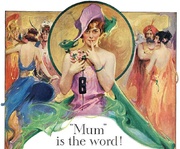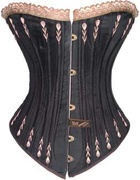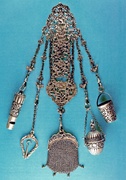
In the fall of 2016, the greatest offense to the olfactory organs of most Americans was undoubtedly the cesspool stench emanating from that year’s presidential election. But a few hundred years ago, the actual smell of civilization was so bad that some people carried offsetting aromas with them in devices such as pomanders and vinaigrettes. By the 18th century, a new category of decorative deodorizers arrived in the form of small vases called tussie-mussies, which could be pinned to one’s clothing or held in the hand, so that one’s nostrils were never far from a fragrant bouquet of sweet-smelling posies.
“Proper ladies didn’t have a lot to do in those days.”
For 25 years, tussie-mussies have been the obsession of Irene Deitsch, whose book, Tussie-Mussies: A Collector’s Guide to Victorian Posy Holders, was recently published by Marene Press. “A ‘tussie’ is a nosegay, which is a Middle English word for a small group of flowers held together in a little bouquet,” Deitsch says, explaining the etymological origins of this curious-sounding collectible. “‘Mussie’ refers to the moss that was moistened and put around the stems of the flowers to keep them from wilting. That’s why they’re called tussie-mussies.”
Irene got her first whiff of the world of tussie-mussies while on vacation in Washington, D.C., with her husband, Marshall, who collects glass paperweights. “We went to the Smithsonian,” she recalls, “and there must’ve been five or six display panels filled with these things. I was entranced.” A few days later, while in Charleston, South Carolina, visiting friends, she bought her first tussie-mussie, a cornucopia shape, in a local silver shop. Deitsch no longer has that first purchase, but over the years, her collection eventually grew to 250 or so pieces, mostly from Europe and Russia. Today, she has around 130 examples, the best of which reside in illuminated cases in the couple’s living room.

Collector Irene Deitsch, with just a few of her tussie-mussies.
In her book, Deitsch organizes her tussie-mussies by their materials—sterling silver, silverplate, gold, ivory, glass, porcelain, mother-of-pearl, straw—as well as their styles—handheld vs. lapel pin, bosom bottle vs. three-legged tripod. While some of these objects may be admired for their beautiful enameling or intricate etching, many are also windows into the courtship customs of privileged young ladies during the Victorian Era, particularly in England. “Some have flirting mirrors on them,” Deitsch says, “so a young woman carrying a tussie-mussie could see who was behind her.” Others sport small flat surfaces holding thin sheets of ivory, upon which the names of gentlemen desiring a dance would be written.
“Over the years, her collection eventually grew to 250 or so pieces.”
In fact, even though combating the odors of society may have been the original motivation for creating tussie-mussies, the pieces quickly became high-society fashion accessories and vehicles for what was known as the language of flowers, which was one of Queen Victoria’s favorite preoccupations. “Proper ladies didn’t have a lot to do in those days,” Deitsch sighs, “so they would garden, get together, and talk about florigraphy—a red rose signified passion, a pink rose stood for a new love, a yellow rose was a sign of jealousy, a white rose a mark of purity, and so forth.” Wearing such well-understood expressions of one’s frame of mind or romantic availability was critical at dinners and balls, since talking about such things in public was simply not done.
If love was often the subtext of a young lady’s tussie-mussie, death could be, too. “If you wore one with certain stones on it, and you were living in Scotland, that would be an example of a funeral or mourning tussie-mussie,” Deitsch says. “Tussie-mussies laden with pearls dripping down like tears were also worn or carried during mourning.”
In the end, though, despite their beauty and capacity for encoded messaging, tussie-mussies were about delivering fragrant aromas, which were often deliberately strong. “During the Victorian Era,” Deitsch says, “women were expected to wear tight corsets. Sometimes the ballrooms were so hot and the corsets were so tight that a woman would faint, so some tussie-mussies had vinaigrettes on them filled with smelling salts.” No doubt there are a lot of American voters who could use a good snort of smelling salts right about now.
(If you buy something through a link in this article, Collectors Weekly may get a share of the sale. Learn more.)

















 Everything You Know About Corsets Is False
Everything You Know About Corsets Is False
 Our Pungent History: Sweat, Perfume, and the Scent of Death
Our Pungent History: Sweat, Perfume, and the Scent of Death Everything You Know About Corsets Is False
Everything You Know About Corsets Is False The Killer Mobile Device for Victorian Women
The Killer Mobile Device for Victorian Women ChatelainesBefore women carried purses, they often relied on chatelaines to keep an ar…
ChatelainesBefore women carried purses, they often relied on chatelaines to keep an ar… Vinaigrettes and PomandersDuring the Renaissance, as European cities became open sewers for human fil…
Vinaigrettes and PomandersDuring the Renaissance, as European cities became open sewers for human fil… Mari Tepper: Laying it on the Line
Mari Tepper: Laying it on the Line Nice Ice: Valerie Hammond on the Genteel Charm of Vintage Canadian Costume Jewelry
Nice Ice: Valerie Hammond on the Genteel Charm of Vintage Canadian Costume Jewelry How Jim Heimann Got Crazy for California Architecture
How Jim Heimann Got Crazy for California Architecture Modernist Man: Jock Peters May Be the Most Influential Architect You've Never Heard Of
Modernist Man: Jock Peters May Be the Most Influential Architect You've Never Heard Of Meet Cute: Were Kokeshi Dolls the Models for Hello Kitty, Pokemon, and Be@rbrick?
Meet Cute: Were Kokeshi Dolls the Models for Hello Kitty, Pokemon, and Be@rbrick? When the King of Comedy Posters Set His Surreal Sights on the World of Rock 'n' Roll
When the King of Comedy Posters Set His Surreal Sights on the World of Rock 'n' Roll How One Artist Makes New Art From Old Coloring Books and Found Photos
How One Artist Makes New Art From Old Coloring Books and Found Photos Say Cheese! How Bad Photography Has Changed Our Definition of Good Pictures
Say Cheese! How Bad Photography Has Changed Our Definition of Good Pictures Middle Earthenware: One Family's Quest to Reclaim Its Place in British Pottery History
Middle Earthenware: One Family's Quest to Reclaim Its Place in British Pottery History Fancy Fowl: How an Evil Sea Captain and a Beloved Queen Made the World Crave KFC
Fancy Fowl: How an Evil Sea Captain and a Beloved Queen Made the World Crave KFC
this is a great article!!! my Buddy Steve Yvaska forwarded it to me….i was lucky enuf to meet Irene when she & her hubby were guests at one of Steve Y’s Antiques classes…..learned a lot from her & never knew “T-M’s” existed.
thank you, jackie
I love this!!
Very interesting article about Tussie Mussies, could have done without the political references though.
I loved your article on tussie mussies. I to am a fan of them so much so that I made 30 of them all different and gave them as gifts for Christmas. most did not know about them and what they was used for, so explained to them. May God Bless
My goodness, can’t we even search the internet for vintage beauties without getting a dose of ugly politics.
Your opening comment is offensive
Really. Do we have to be so offensive. Last time I checked we were still living in America. Your political overtones ruined the info on tussie mussies
What could have been a good article on a very interesting topic, was marred by your insertion of politics, which had nothing to do with the topic. Your attempt a cleverness fell flat and you did a disservice to Ms. Deitsch, a truly remarkable collector.